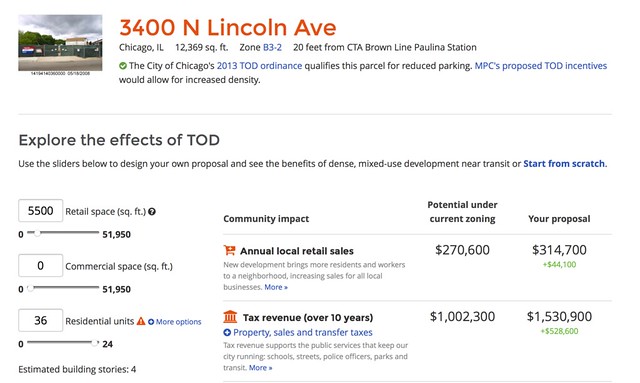
Yesterday, the Metropolitan Planning Council launched “Grow Chicago,” a new policy change initiative to unleash growth in the city by leveraging our public transportation assets and promoting transit-oriented development.
The push includes a report penned by MPC and the Institute for Transportation and Development Policy recommending broader zoning and financial incentives to attract more development near rapid transit stations. The Grow Chicago website also features an interactive TOD calculator that will help quantify the potential benefits of proposed developments.
MPC executive vice present Peter Skosey, project manager Yonah Freemark, and communications director Mandy Burrell Booth discussed the new campaign. “We’re at a point in time in this country where people are gravitating towards cities with good transit systems,” said Skosey. “Chicago needs to capture that growth and ride that trend." He noted that the populations of other cities with mature transit systems are growing at a much higher rate. Minneapolis, with even harsher winters than Chicago’s, is growing five times as fast.
“We need to build on this asset we have and make it possible for more people to avail themselves of the benefits of public transit,” Skosey said. He pointed out that while Chicago has recently seen growth downtown and in parts of the Southwest Side, “hot” transit-friendly neighborhoods like Lincoln Square and North Center have actually been losing population. This can partly be attributed to deconversion (reducing the number of units in buildings), smaller households, and high demand for housing, which leads to higher prices and rent.
While Grow Chicago seeks to create more housing in high-demand areas, it also aims to ensure that development near transit benefits Chicagoans of all income levels, according to Burrell Booth. “We’re advocating for including affordability in strong housing markets, and also using TOD to bring amenities to underserved neighborhoods.”
The website summarizes the different proposed initiatives. While the city’s 2013 transit-oriented development ordinance has been wildly successful in encouraging new projects, with over 20 buildings proposed and six currently under construction, the MPC/ITDP report calls for expanding it. The law currently reduces the minimum parking requirements and allows additional density for new and renovated buildings located within 600 feet or a rapid transit stop, 1,200 feet on designated Pedestrian Streets.
The report recommends providing these incentives for all new construction within at least 1,200 feet of stations, possibly further away, and doing away with minimum parking requirements within these zones altogether. It also calls for streamlining the approval process for TOD projects.
“We’re not calling for completely eliminating parking at these buildings,” Skosey said. “But let’s let the developer and the community make that decision on the right amount based on actual market demand, which the TOD calculator will help predict, rather than having the zoning ordinance dictate it. Excess parking spaces are $20,000 a pop, and that translates to higher sale prices and rents.”

MPC and ITDP also recommend prioritizing existing public funding streams towards areas near transit, and encouraging financial institutions to focus their lending in these districts. “We would argue they would get a better return on investment because of TOD,” Skosey said. They also want to see new types of loans and grants created to encourage the creation of affordable housing in strong housing markets near transit, as well as retail and other amenities near stations in weaker markets.
The reports calls for forming a civic coalition to promote TOD, including reps from community, financial, development, nonprofit, and governmental organizations. It also recommends that Chicago hire a TOD manager to serve as a single point of contact for city departments, developers, and community groups.
Of course, dense, parking-lite development can only move forward if a critical mass of local residents is comfortable that it will be good for the neighborhood and won’t cause a parking crunch. The TOD calculator may help win hearts and minds by providing well-informed projections of what the benefits of a new building would be. The application allows people to input the location, size, and type of development and calculate the positive impact in terms of additional retail sales, tax revenue, nearby jobs, residents, annual transit rides, and affordable housing units.
Some of the data for the TOD calculator comes from the Chicago Cityscape online development tracker created by Streetsblog Chicago's Steven Vance -- MPC contracted him to repackage the info. Other data sources include the U.S. Census, the Cook County assessor’s office, the city’s open data portal, and a series of national studies about the benefits of living near transit, according to Freemark.
For example, Bureau of Labor statistics were used to predict how much money people living in TOD in various neighborhoods can be expected to spend on retail. All of the methodology is documented on the Grow Chicago website. “We hope people will use the calculator to get good info about what new developments would mean to their communities,” Burrell Booth said.
The Grow Chicago report and the TOD calculator should be powerful tools for building support for dense, low-parking housing near transit. As it stands, many residents have trouble wrapping their heads around the fact that this kind of development will make their communities more livable, not less. In the future, we’ll be including plenty of data from the calculator in SBC articles on TOD.




